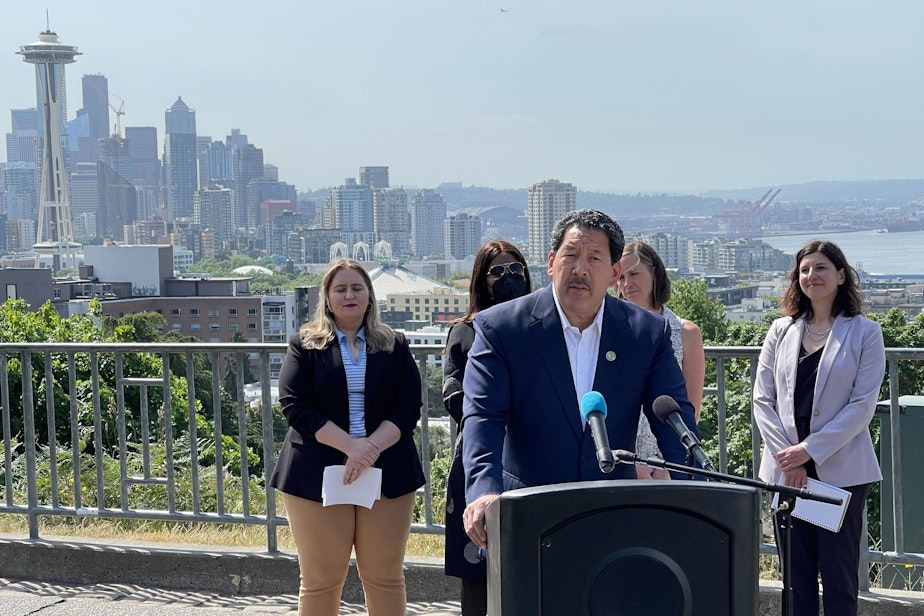Seattle aims for cleaner buildings over next 25 years

Seattle’s biggest buildings would have to reduce their impact on the climate starting eight years from now under a proposal announced Thursday by Seattle Mayor Bruce Harrell.
Seattle officials say the "Building Emissions Performance Standards" would make a major dent in the city’s pollution, while some critics say the plan lacks the urgency needed in a climate emergency.
Buildings are the fastest-growing source of climate pollution in Washington, according to the Washington Department of Commerce. They generate more than one-third of Seattle’s greenhouse gas emissions, according to Seattle’s Office of Sustainability and Environment.
Efforts to address buildings’ impacts have mostly focused on how new ones get built — it is easier to design new buildings to save energy and not rely on fossil fuels than it is to retrofit the heat and hot-water systems of existing buildings.
The mayor’s proposal targets the energy used by existing buildings.
“While there are regulations in place to address emissions in new buildings, as you can see, behind us, we have many existing buildings that need a trajectory toward a clean energy future,” Harrell said at a press conference in Seattle’s Kerry Park. “That's what this work does.”
Sponsored
Depending on their size, large office buildings would have to produce no pollution by 2045, while apartment buildings would face a 2050 deadline.
The biggest buildings would have to go first, with skyscrapers and any other structures bigger than 220,000 square feet needing to make their first emissions cuts by 2031, while 20,000-square-foot buildings would have to cut back by 2035.
(For comparison, Seattle’s historic, 42-story Smith Tower has about 270,000 square feet of space, while the 14-story Joseph Vance Building downtown is about half that size.)
“We think these are achievable. They're aggressive,” Harrell said.
But not everyone agreed.
Sponsored
“We're in a climate emergency. We need to go faster than this,” said climate activist Andrew Eckels with 350 Seattle. “Under the current policy, most building owners don't have to do anything until the early 2030s, and they don't have to finish moving off fossil fuels until the late 2040s, which we know from the most recent IPCC [U.N. Intergovernmental Panel on Climate Change] report is really not fast enough for the urgency of what we're dealing with.”
Building owners say 2031, eight years from now, is too soon to make major changes to their infrastructure when such projects can take years to complete.
“It's overly aggressive. It's too fast. It costs too much,” said Rod Kauffman, head of the Building Owners and Managers Association Seattle King County. “The value of commercial real estate out there, more or less, has dropped 30% in the last couple of years, and many of those buildings are underwater right now.”
For the first five years, building owners would have the option, instead of reducing their emissions, of paying a fee per ton of pollution they emit beyond the new limits. Low-income apartments as well as buildings with “extremely high” vacancy rates or financial distress could also get an extra five years to start reducing their emissions.
“Those are largely multimillion, multibillion-dollar real estate asset portfolios that can absolutely afford to go faster, and we can't afford to wait longer,” Eckels said of the major buildings in downtown Seattle.
Sponsored
“Affordable housing projects, their building portfolios operate within very tight budget margins,” said Patience Malaba, head of the Housing Development Consortium, a group of affordable housing developers and providers in King County.
And yet, Malaba said at the mayor’s press conference, “It is incumbent upon all of us that we truly take action to significantly reduce greenhouse gas emissions over the next decade.”
“Whether it's transit emissions, whether it's our reliance on fossil fuel for other types of issues, whether it's our building standards, we just come up with what we think are realistic, but aggressive goals. And we're not trying to put out there unrealistic goals,” Harrell said.
Seattle’s Green New Deal law, passed in 2019, requires the city to aim for a goal of carbon neutrality by 2030, not 2050. Under Washington state law, greenhouse gas emissions statewide must come down 95% by 2050, with shorter-term reductions mandated along the way.
Harrell’s proposal originally required buildings to start polluting less in 2027, but that deadline was delayed to 2031 after pushback from building owners.
Sponsored
Seattle Office of Sustainability and Environment Director Jessyn Farrell said the proposal includes early incentives for buildings to clean up their act before the deadlines.
“Our goal really is to get people to decarbonize as quickly as possible,” she said.
Environmental activists and building owners both say they plan to keep lobbying on the buildings proposal as the Seattle City Council debates it in the months ahead.
Harrell’s proposal follows similar measures enacted in other cities including Boston, Denver, and St. Louis.




